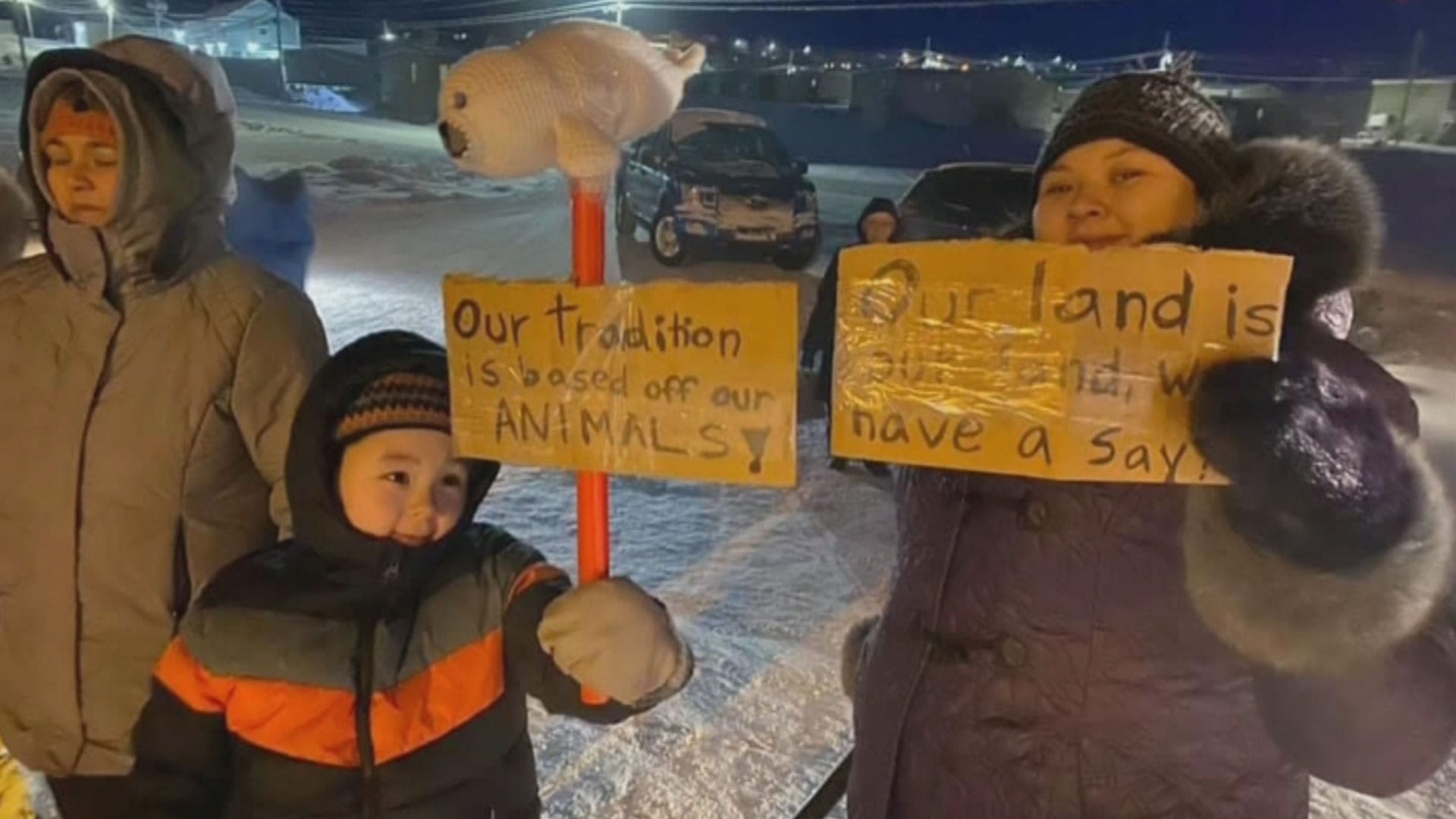Inuit protestors blocked the airstrip and access road of the Mary River iron ore mine in North Baffin Island on Feb. 4, forcing a stop to mining and leaving the 700 mine employees stuck.
Now, other Inuit, territory wide have joined in with the protest, which shows no sign of letting up.
Inuit in the two closest communities – Pond Inlet and Arctic Bay – have said they are joining the protestors with supplies.
Baffinland, the owners of the mine, have been seeking to double production from six to 12 million tonnes annually and put in a railway to aid shipping.
They have been applying to the Nunavut Impact Review Board [NIRB] to make this move since 2014, when the mine opened for business.
Many Inuit in the area say that since more mine ships started arriving, whales and seals have been harder to find.
Near the mine site, bright red iron dust makes clean snow look like a Prince Edward Island dirt road.
Many fear that the proposed railway will scare off caribou, which are already very hard to find on Baffin Island even with strict quotas in place.
On Jan. 25, the NIRB started hearings in Pond Inlet to hear technical evidence on environmental impact, which ended on Feb. 6.
That last day was the only day for members to the public to ask questions and make statements.
While the protestors held the mine in lockdown, their community members made their case to the three person NIRB panel.
Caleb Sangoya is a Pond Inlet hunter and has been writing down his observations about wildlife around the Mary River since 2009, when the idea of a mine was proposed.
“Baffinland says no drop has taken place,” said Sangoya in Inuktitut. “From our observation, no way. When there’s ship traffic, mammals start to move away.”
Pond Inlet resident Nina Kautuq expressed a sentiment that has been coming up over Nunavut’s dinner tables since the blockade began.
“I’m asking you, can you slow down,” said Kautuq. “We’re not trying to close down Mary River, but can you slow down your proposal?”
Although Baffinland has failed to hit their agreed upon Inuit employment, their economic impact on Baffin Land is expansive.
Just over 13 per cent of their workforce are Inuit, well short of their promised goal of 50 per cent, but do employ over 200 Nunavut Inuit at the mine site.
A more telling figure is the $200 million they have spent with Inuit owned business.
The biggest beneficiary of Baffinland may be the Qikiqtani Inuit Association (QIA), the group that represents Baffin Island Inuit.
The Mary River mine is on Inuit Owned Land, as defined by the Nunavut Land Claim. Under that land claim, QIA -as the regional land claim group- are effectively Baffinland’s landlords
They renegotiated their Inuit Impact Benefits Agreement with Baffinland in 2018. The result includes $10 million towards a training centre in Pond Inlet, $2.25 million a year toward Inuit training, $400,000 a year to provide hunters with gas and an agreement to buy a boat for a Nunavut community’s hunters every three years.
That’s all in addition to annual royalty payments that start at 1.19 per cent of profit and will eventually grow to 3 per cent.
For QIA, a successful expansion would also trigger a $45 million bonus.
The owners of Baffinland estimate the value of the agreement to be near $1 billion over the life of the mine.
The protestors at Mary River have placed the blame squarely at the feet of QIA.
They have a satellite phone at the mine site, and released an audio statement in Inuktitut on Feb. 4, after they had blocked operations. In it, they say, “It is due to Qikiqtani, QIA’s actions on the Mary River Phase 2 project we are protesting at Mary River. QIA has treated Inuit haphazardly. Hunters are not considered, communities are not considered, Inuit are not considered, and are only given the means to stay silent,” says the person in the statement, who has not been named.
In a statement today, Baffinland went one step farther, saying the protestors of want to form their own Inuit Association to supplant QIA.
“Baffinland understands that requests have been made by the organizers to be recognized as a Designated Inuit Organization under the Nunavut Agreement and for a portion of the royalties payable by Baffinland under the Inuit Impact and Benefit Agreement to be paid directly to them.”
In the North Baffin region, the idea of a separate Inuit Association to better represent the area has been floated in recent years.
Now, protests are starting to happen territory wide.
On Feb. 5, women and children with signs met the NIRB officials as they left the hearings.
Today in Taloyoak, residents gathered in a show of support.
The NIRB hearings were supposed to wrap up on Feb. 6, but have been extended to include two more weeks in March in Iqaluit, with up to five representatives from each of the seven nearest communities. The final decision will not end up with NIRB however. NIRB’s role is to make a recommendation to the federal government, who can choose to ignore or approve the plan.











